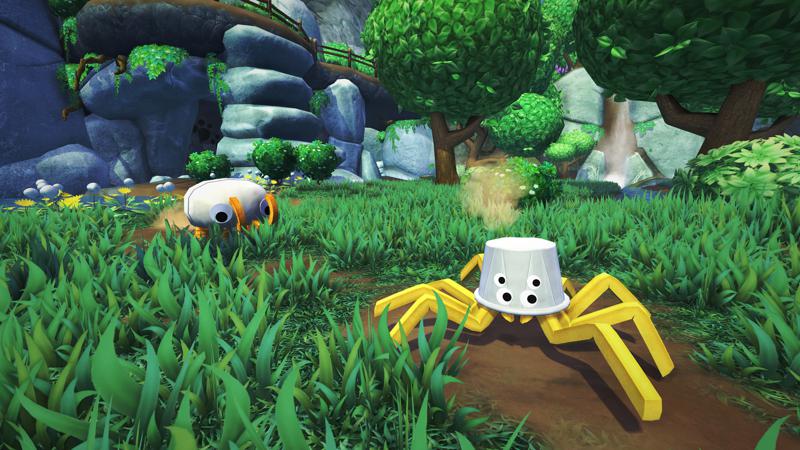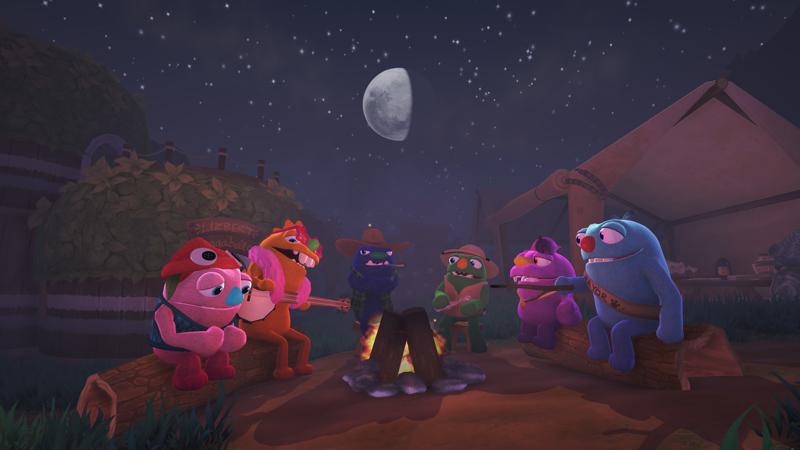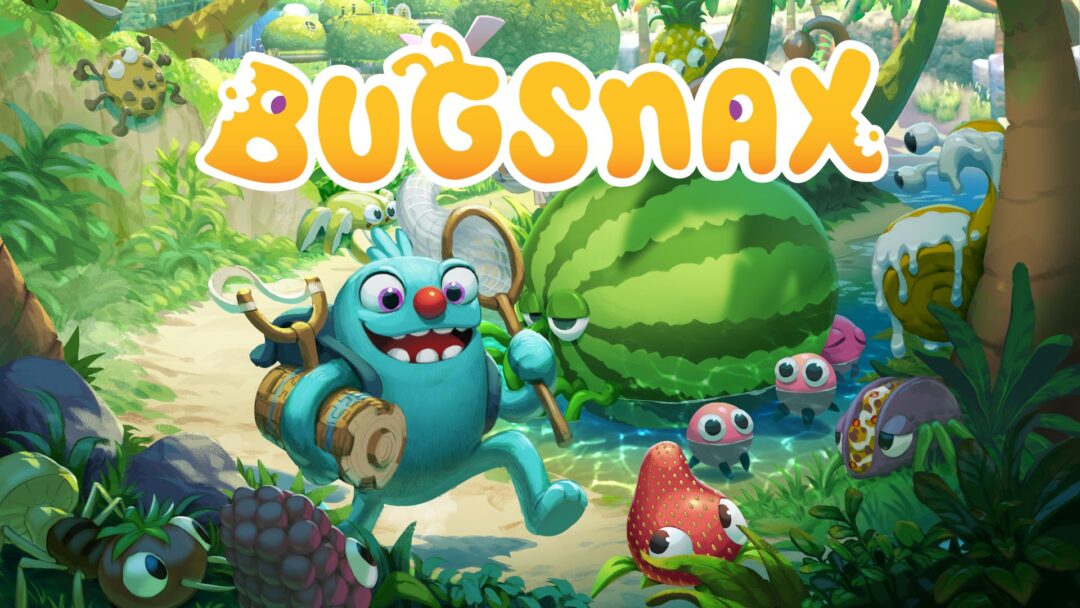In a way, I’m glad that I’m not interested in many platform exclusives. Sony’s first party lineup is becoming increasingly homogeneous, Microsoft’s pay-2-win business strategy has yet to produce much output, and outside of a 3D Mario or Pokémon, I barely even pick up my Switch. When the PS5 launched, I’d had my fill of narrative heavy gruff ‘n tuff adventures, and looking to repeat the same arrogant doggedness Microsoft showed the generation before, I gave it a miss. But one game caught my eye for it’s complete tonal juxtaposition to the typical Sony headliner: Bugsnax
I didn’t even know much about it. A few promotional shots illustrated a colourful catching collectathon, Spore-like in the way its collection of characters appeared, with gangly limbs and furry textures. A Pokemon competitor? Goofy nature simulator? The main thing was that it was different, undeniably indie and yet had enough of a marketing budget to appear alongside a launch campaign with Astro’s Playroom, Sackboy: A Big Adventure, Demon Souls, and Spiderman: Miles Morales. With a full playthrough now behind my belt, I can say I’m glad Bugsnax made its way to other platforms, for while it’s messy to a degree which has me scratch my head at plenty of design decisions and surprisingly rough for a “next gen” launch title, by and large it’s a joyful, Rare-like romp with plentiful well design creatures to capture, character moments which humour and confuse in equal parts and contains an ending so bizarre I couldn’t help but adore it.
I’ve seen Bugsnax described as a “Pokémon style game”, hence my prior query, but upon play through its apparent similarities end at affable oddball creatures. We do plenty of catching though, as the isle of Snaktooth is ripe for discovery, the titular Bugsnax infest the island from ground to sky, all of which hybrid animals take elements from both foods and bugs to manifest ugly, chaotic yet wholly fascinating creatures. We play a journalist invited to the island by famed explorer Elizabert Megafig to break a story on the newly discovered critters, but our investigation immediately turns to one of confusion and danger as we crash land, quickly finding out Elizabert is missing and the small town she had previously constructed has been abandoned. The new scoop: rebuild Snaxburg, discover the local fauna, and find the missing adventurous Grumpus.
There are two species on Snaktooth: Bugsnax and Grumpuses. The latter are what we are, and Elizabert, and the entirety of what was the local invasive populace. Multicoloured, hairy humanoids, they’re much like us humans, only less hairy in the case of some men I’ve seen. Bugsnax are the aforementioned hybrids; half bug, half snack creatures which Grumpuses love to catch and eat. Only, where overconsumption of food in the real world causes obesity and heart disease, the only apparent effect of Bugsnax-snacking is that one of your limbs morphs into part of the recently chomped bugsnax.
But how do we attain that foreign delicacy? Well first we have to observe them, and thus begin the hunt for every species on Snaktooth. Our camera allows us to analyse a bugsnax and reveal its preferences, along with its habitat, time of activity, characteristics, and finally highlighting the trail it’s currently following. It’s moderately detailed, perhaps more than the game ends up needing, but it’s no encyclopaedia. Regardless, we’re given the information to catch them, and we quickly build an arsenal of tools to nab them. A remote trap is key to almost every capture, acting as our clunky Pokeball, while tertiary tools like the launchpad, trip wire and slingshot make use of gravity, the terrain and the native condiments to make catching airbourne, speedy or equally hungry bugsnax possible.

It’s a fun system when you finally crack the code into a tricky bugsnax, one whose journal entry details scarce information, and you rely on sheer puzzle solving prowess to catch. The core catching mechanic is at its best when tools combine in an initiative way. The trip shot can stun bugsnax which walk through its barbs, but it also transmits elements, resulting in certain bugs needing not only to be tripped, but lured into it with a splat of ketchup from the slingshot, and then set alight by the wires proximity to a fiery sconce. It’s a sporadic joy, however, as our tools are imprecise in execution and bugsnax often fickle in their supposed predilections. Setting up a perfect trap just to have a bugsnax wander off and attack a nearby annoying bug is a common sight. The trip shot progressively becomes your most critical tool due to its stunning capabilities, but its reliance on specific terrain to set up, along with bugsnax consistently mugging you off by betraying their supposed trail. Other tools like the launchpad and buggyball – or even just the standard trap – all suffer with a degree of delay, making some of the more time-dependent aerial captures a struggle. The launchpad was particularly hokey, sometimes launching the object exactly where I aimed, other times plopping it pathetically a few centimetres in front of it.
Depth isn’t a strong point for Bugsnax, as even some of the information in the paper-thin journal entries isn’t used meaningfully. Most bugsnax are s with descriptors like their colour, aggression level and flavour profile – Bungers, a beetle/burger hybrid, are aggressive, meaty boys, while the puny Strabby, a strawberry aphid, are red and fruity. It’s cause for excitement, thinking of how a more boisterous, carnivorous bugsnax might chase anxious, juicy prey for an easy nab on our part, but outside of inherent indiscriminate rage, bugsnax interact with each other in a limited way. I was immediately disappointed to see that caught bugsnax serve no function. They’re merely objects of Snaxburg’s residents’ desire, creatures to be caught to further dialogue, and have no purpose outside of actually catching them.
It’s arguably the biggest point of separation between it and a game like Pokemon. Where one balances the hunt for monsters and the battling of them fairly well, Bugsnax exclusively targets the former, and in doing so establishes expectations for something more meaningful than tossing a Pokeball at the beast. It does in the sense there’s more tools to work with, and while the missed opportunities and general looseness of control is frustrating, it’s made worth it through captivating creature designs. It’s something Pokémon does extremely well, so much so that even competitors with better gameplay mechanics like TemTem are denied a landslide victory over the JRPG titan, forgetful and unimaginative designs padding out the bulk of the games collectible monsters. While Bugsnax’s foundation is one of missed opportunities, it’s roughly enjoyable enough that I felt compelled to collect all the critters, which wouldn’t exist were it not for inventive and affable designs.

The aforementioned “Bunger” makes an early appearance, but sticks to memory for long after with its perpetual goofy cry and excited hopping towards anything it wishes to send flying across the map. In terms of representation, we’ve got plenty of different food groups combining with a vast array of crustaceans, insects and arachnids.The slimy texture of an egg meets the gloopy form of a slug with the “eggler”, “popticks” initially exist as a tiny (you guessed it) tick like a popcorn kernel, and when set alight spring into action, evolving into their final form as the spongy treat we know and love. The common pickle, a mushy and somewhat fragile acidic snack, exists in Bugsnax calcified by human ingenuity, protected by a glass jar, and proves a different challenge in catching as the “Pinkle” first requires freeing from its commercial armour. Reviewing all the different bugsnax now gives me even more appreciation for the thoughtfulness which went into designing them. It’s easy to stick snacks in one generator, bugs in another, and excrete a resulting template to create a creature, but every bugsnax in the game is completely logical and representative of their realworld source material, which not only makes the puzzle solving aspect more transparent, but makes each creature so much more captivating than otherwise random designs, and serves as primary motivation for wanting to explore each and every area.
Speaking of areas, and more broadly how they look, Snaxtooth Island is split into distinct zones for exploration. Centerly we have Snaxburg, a once thriving but recently deserted town which acts as a hub for our adventures. We gradually repopulate it at the incumbent mayor’s request, scouring the other handful of other biomes for the ex-citizens. They range from the tropical beaches of the Simmering Springs to the chilly cold front of the Frosted Peaks. A Grumpus or two have made abodes in each one, and through short questlines we convince them to head back to Snaxburg. Each area radiates Rareware-style beauty, utilising bold, basic themes and colours to smack you right across the face with palpably energetic levels, filled with thematically fitting Bugsnax and equally charming Grumpus’ to find. They all employ entry-level writing tropes: Wiggles is a flamboyant pop star, Wampus is a grumpy farmer, Beffica a drama-provoking youth. And yet I quickly found myself charmed by them, when they could have irritated me with ease. Beffica especially, I don’t even have to elaborate on why someone talking in textspeech could utterly infuriate you. Bugsnax has a way of turning characters with surface level personalities into more than a sum of their parts. Beffica might be an annoying gossip, but her questline exposes how shallow she knows she is. Wiggles too, bursting with energy for almost the entire game, fall to their knees eventually, admitting their conquest for fame has diluted the artform they love. Additionally, for every Beffica there is a Filbo, the alkaline to her acid. Chandlo, a seemingly dimwitted “Chad”, and his head-in-the-clouds brainiac partner, Snorpy, play off each other in a way which acknowledges the simplistic personality traits which define them, yet has the poise to subvert any traditionally dull end to their character arcs.
And speaking of subversion, I have to mention the ending, in a roundabout way to avoid spoilers; a finale which baffles, excites, humours and shocks me, all in equal parts. As our investigation comes to a close, rounding up our fellow Grumpus’, repopulating Snaxburg and piecing together the whereabouts of Elizabert, we’re met with a complete tonal pulling-of-the-rug, in, what remains a week after completing it, one of the most memorable narrative flourishes to recent memory. Whether or not it’s fully earned, I’m undecided, and I think it’s something which might fail to land with many players, but I will note that the games melancholic finale to each side characters storyline somewhat provokes this sort of ending, one which causes us to reflect on bugsnax as creatures, their purpose, the Grumpus’ view on them and, subsisting bugsnax for real world animals, our own treatment of the creatures which roam earth.
It might be a stretch, and I’m fully willing to admit that my vegan tendencies have pushed me into a mindset akin to the internet’s infamous villain, the English Lit teacher extracting meaning out of the blue curtain, but there seems to be an attempt at commentary between our own overconsumption and that of the Grumpus’ voracious adoration for bugsnax.
I’m ultimately glad developers Young Horses took the punt with a rather outrageous ending, because there’s a fear with game’s which only last only a handful of hours, achieving a generally “good” experience isn’t enough to have it stick to memory after the first month. And Bugsnax is generally “good”. There’s some rough, sloppily drawn edges – sometimes literally in the case of its visual fidelity which doesn’t seem to match my next gen console expectations – other times less literal, as is with the case of its loose and imprecise controls, but it has personally, invigorated by superb character designs, a likeable cast and a gameplay loop with does just enough to remain enjoyable. That right there, is a generally “good” game, but Bugsnax takes a leap of faith into the ludicrous; the baffling; the surprising and decisively fascinating in its final few set pieces. There’s improvements to be made in the future, and if a sequel comes along someday, I’ll remember exactly why I’m excited for it.

